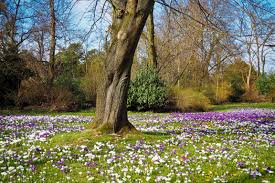
Environmental & Science Education
STEM
Climate Change
Biodiversity
Edward Hessler
Today is the Vernal Equinox, the astronomical marker of the spring season. Today's Google Doodle (March 20 2018) celebrates this change and leads to more information. Since it is the first day of spring it is time to light out for the territory, spring is moving north and we can watch it thanks to technology.
In North with the Spring, the late naturalist Edwin Way Teale compiles a natural history of spring as he traveled just behind it's advancing front. It was first published in 1951 and was a treasure then and still is today.
Little did Teale know when he was making this journey that it would be followed many years later by a National Phenology Network which is now accessible on the web for everyone interested in checking some of the vital signs of our part of the planet.
About this year's spring, the NPN network notes that Spring continues to arrive early in the west and late in the east, compared to a long-term average (1981-2010). Spring is 22 days early in Cincinnati, and 14 days early in Baltimore. On the other side of the country, the spread of spring is still stalled from California to Washington.
Of course, we want to know when spring begins where we are as well as how it can be tracked. First appearance of the tiniest of tree leaves. Fat, swollen buds showing some green? Crocuses on lawns? Skunk cabbage? To answer this question the USA-NPN uses a Spring Leaf Index is a synthetic measure of these early season events in plants, based on recent temperature conditions. This model allows us to track the progression of spring onset across the country.
This is a data-rich site with help on accessing and using it. Interested in how spring progressed in 2017? There is a week-by-week animation linked and you might want to use that to make a visual comparison with the reports for 2018.
I like the definition of phenology found on the site. It is nature's calendar...when things happen out there in the world around us. There are challenges in recording such data, e.g., keeping records, deciding "what counts" as first signs of spring. Cindy Crosby who writes one of my very favorite blogs, Tuesdays in the Tallgrass, included this about skunk cabbage in her entry for February 27, 2018. I love this elusive plant. Although it can poke through the snow as early as December in the Chicago region, seeing it emerge always says “spring” to me. When I was a kid it said the same thing to me.

University of Minnesota entomology professor Alexander Hodson (1906-1996) noted first leafing and flowering, a total of 14 phenological events, for woody plants on or near the St. Paul Campus of the University during a 51-year period (1941-1991). These data are archived at the University of Minnesota where you can view his original notebooks.
Such data have become more and important. The website provides a compelling reason. Changes in phenological events like flowering and animal migration are among the most sensitive biological responses to climate change. Across the world, many spring events are occurring earlier—and fall events are happening later—than they did in the past. However, not all species are changing at the same rate or direction, leading to mismatches. How plants and animals respond can help us predict whether their populations will grow or shrink – making phenology a “leading indicator” of climate change impacts.
The University of Minnesota has a Backyard Phenology project about which you may learn more here.
The University of Minnesota has a Backyard Phenology project about which you may learn more here.

No comments:
Post a Comment